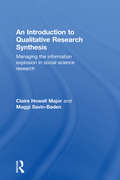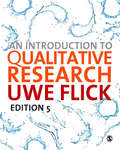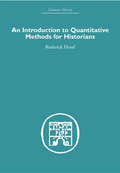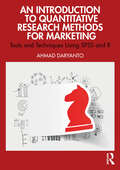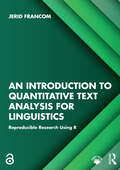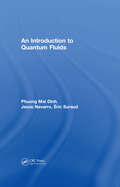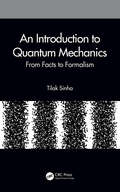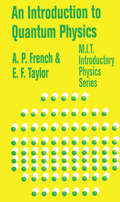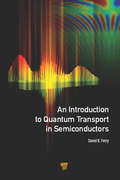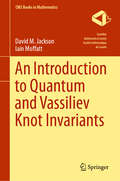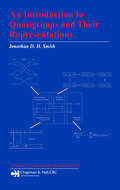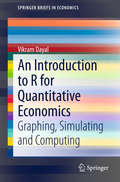- Table View
- List View
An Introduction to Qualitative Research Synthesis: Managing the Information Explosion in Social Science Research
by Claire Howell Major Maggi Savin-BadenProviding a comprehensive guide for understanding, interpreting and synthesizing qualitative studies, An Introduction to Qualitative Research Synthesis shows how data can be collated together effectively to summarise existing bodies of knowledge and to create a more complete picture of findings across different studies The authors describe qualitative research synthesis and argue for its use, describing the process of data analysis, synthesis and interpretation and provide specific details and examples of how the approach works in practice. This accessible book: fully explains the qualitative research synthesis approach; provides advice and examples of findings; describes the process of establishing credibility in the research process; provides annotated examples of the work in process; references published examples of the approach across a wide variety of fields. Helping researchers to understand, make meaning and synthesize a wide variety of datasets, this book is broad in scope yet practical in approach. It will be beneficial to those working in social science disciplines, including researchers, teachers, students and policy makers, especially those interested in methods of synthesis such as meta-ethnography, qualitative meta-analysis, qualitative meta-synthesis, interpretive synthesis, narrative synthesis, and qualitative systematic review.
An Introduction to Qualitative Research: Bachman, The Practice Of Research In Criminology And Criminal Justice 4e + Flick, An Introduction To Qualitative Research 4e
by Dr Uwe Flick\In the new edition of his bestselling book, Uwe Flick introduces all of the main theoretical approaches to qualitative research, and provides unmatched coverage of the full range of methods now available to qualitative researchers. Organised around the process of doing qualitative research, the book guides you through ethics, research design, data collection, and data analysis. <P><P> In this fifth edition, you will find:<P> * a new chapter outlining methodological approaches to qualitative research <P> * new introductory sections at the beginning of each of the book's seven parts, which prepare the ground and define key terms <P> * lots of new practical examples which show you how to carry out all aspects of a qualitative research project <P> * new exercises that give you the opportunity to test your understanding of what you've read <P> * a brand new companion website full of resources for lecturers and students including suggested answers to the exercises in the book, full text journal articles and links to additional resources: http://uk.sagepub.com/flick5e
An Introduction to Qualitative Research: Becoming Culturally Responsive
by Maria K. LahmanThis engaging introduction to all aspects of qualitative research challenges students to consider how their research can be culturally responsive. The first part of the book introduces the foundations including theory, ethics, and reflexivity, with an emphasis on multiple methodologies, from traditional to critical and cutting-edge. The second part covers practical guidance from writing proposals to data collection, and includes a chapter dedicated to creating a culturally responsive relationship with research participants. Finally, readers engage with how the quality of research is enhanced, how data are analyzed, and how research accounts are created and disseminated. Areas vital to the health of qualitative research are addressed including systemic racism and cultural humility, with cutting-edge suggestions offered in areas like hybrid research, harnessing technology, and use of social media. Multiple identities are centered in examples throughout including race, gender, and those who are hard to reach or seldom heard in research. Textboxes featuring scholars, student researchers, and community members invite readers into dialogue in an area that is contested, swiftly shifting, and always vibrant with potential. Resources for instructors are available on a website to accompany the book at: https://edge.sagepub.com/lahman
An Introduction to Qualitative Research: Becoming Culturally Responsive
by Maria K. LahmanThis engaging introduction to all aspects of qualitative research challenges students to consider how their research can be culturally responsive. The first part of the book introduces the foundations including theory, ethics, and reflexivity, with an emphasis on multiple methodologies, from traditional to critical and cutting-edge. The second part covers practical guidance from writing proposals to data collection, and includes a chapter dedicated to creating a culturally responsive relationship with research participants. Finally, readers engage with how the quality of research is enhanced, how data are analyzed, and how research accounts are created and disseminated. Areas vital to the health of qualitative research are addressed including systemic racism and cultural humility, with cutting-edge suggestions offered in areas like hybrid research, harnessing technology, and use of social media. Multiple identities are centered in examples throughout including race, gender, and those who are hard to reach or seldom heard in research. Textboxes featuring scholars, student researchers, and community members invite readers into dialogue in an area that is contested, swiftly shifting, and always vibrant with potential. Resources for instructors are available on a website to accompany the book at: https://edge.sagepub.com/lahman
An Introduction to Qualitative Research: Learning in the Field
by Sharon F Rallis Gretchen B RossmanThe updated Fourth Edition of Rossman and Rallis’s popular introductory text leads the new researcher into the field by explaining the core concepts through theory, research, and applied examples. Woven into the chapters are three themes that are the heart of the book: first, research is about learning; second, research can and should be useful; and finally, a researcher should practice the highest ethical standards to ensure that a study is trustworthy. The Fourth Edition includes an elaborate discussion of systematic inquiry as well as a nuanced discussion of developing a conceptual framework.
An Introduction to Qualitative Research: Learning in the Field
by Sharon F Rallis Gretchen B RossmanThe updated Fourth Edition of Rossman and Rallis’s popular introductory text leads the new researcher into the field by explaining the core concepts through theory, research, and applied examples. Woven into the chapters are three themes that are the heart of the book: first, research is about learning; second, research can and should be useful; and finally, a researcher should practice the highest ethical standards to ensure that a study is trustworthy. The Fourth Edition includes an elaborate discussion of systematic inquiry as well as a nuanced discussion of developing a conceptual framework.
An Introduction to Quantitative Economics (Routledge Library Editions: Econometrics #8)
by Brian HainesOriginally published in 1978. This book is designed to enable students on main courses in economics to comprehend literature which employs econometric techniques as a method of analysis, to use econometric techniques themselves to test hypotheses about economic relationships and to understand some of the difficulties involved in interpreting results. While the book is mainly aimed at second-year undergraduates undertaking courses in applied economics, its scope is sufficiently wide to take in students at postgraduate level who have no background in econometrics - it integrates fully the mathematical and statistical techniques used in econometrics with micro- and macroeconomic case studies.
An Introduction to Quantitative Methods for Historians (Economic History Ser.)
by Roderick FloudMany statements made by historians are quantitative statements, involving the use of measurable historical evidence. The historian who uses quantitative methods to analyse and interpret such information needs to be well acquainted with the particular methods and techniques of analysis and to be able to make the best use of the data that are available. There is an increasing need for training in such methods and in the interpretation of the large volume of literature now using quantitative techniques. Dr Floud’s text, which is relevant to all branches of historical inquiry, provides a straightforward and intelligible introduction for all students and research workers. The simpler and more useful techniques of descriptive and analytical statistics are described, up to the level of simple linear regression. Historical examples are used throughout, and great attention is paid to the need to ensure that the techniques are consistent with the quality of the data and with the historical problems they are intended to solve. Attention is paid to problems of the analysis of time series, which are of particular use to historians. No previous knowledge of statistics is assumed, and the simple mathematical techniques that are used are fully and clearly explained, without the use of more mathematical knowledge than is provided by an O-level course. A bibliography is provided to guide historians towards the most useful further reading. This student friendly text was first published in 1973.
An Introduction to Quantitative Research Methods for Marketing: Tools and Techniques Using SPSS and R
by Ahmad DaryantoThis introductory text covers the foundational concepts and statistical applications of quantitative research techniques using SPSS and R.Using step-by-step examples throughout, the book is broken down into six core sections: Part 1 covers an introduction to quantitative research methods and how to get started with SPSS and R; Part 2 covers basic concepts in measurement, data descriptions, and distributions; Part 3 discusses hypothesis testing, and basic statistical tests; Part 4 covers regression analysis; Part 5 discusses advanced topics in regression analysis and analysis of variance; and finally Part 6 covers advanced statistical methods. Each chapter contains learning objectives and summaries to structure learning, while breakout boxes provide tips and draw students’ attention to dos and don’ts in statistical research. SPSS and R Action Boxes present step-by-step instructions on how to perform statistical tests and procedures with SPSS and R. Review questions prompt self-reflection on concepts taught in each chapter and are complemented by exercises that allow students to put their learning into practice.A very applied text designed to make this complex subject accessible to students with no background in quantitative methods, this book is valuable recommended and core reading for advanced undergraduate and postgraduate students studying business and marketing research methods, business analytics, marketing analytics, statistical skills and quantitative methods.Online supplementary resources include data sets and programming files.
An Introduction to Quantitative Text Analysis for Linguistics: Reproducible Research Using R
by Jerid FrancomAn Introduction to Quantitative Text Analysis for Linguistics: Reproducible Research Using R is a pragmatic textbook that equips students and researchers with the essential concepts and practical programming skills needed to conduct quantitative text analysis in a reproducible manner. Designed for undergraduate students and those new to the field, this book assumes no prior experience with statistics or programming, making it an accessible resource for anyone embarking on their journey into quantitative text analysis.Through a pedagogical approach which emphasizes intuitive understanding over technical details, readers will gain data literacy by learning to identify, interpret, and evaluate data analysis procedures and results. They will also develop research skills, enabling them to design, implement, and communicate quantitative text analysis projects effectively. The book places a strong emphasis on programming skills, guiding readers through interactive lessons, tutorials, and lab activities using the R programming language and real-world datasets.This practical textbook is enriched with features that facilitate learning, including thought and practical exercises, a companion website that includes programming demonstrations to develop and augment readers’ recognition of how programming strategies are implemented, and a GitHub repository that contains both a set of interactive R programming lessons and lab exercises, which guide readers through practical hands-on programming applications. This textbook is an essential companion to any linguist looking to learn how to incorporate quantitative data analysis into their work.The Open Access version of this book, available at http://www.taylorfrancis.com, has been made available under a Creative Commons Attribution-Non Commercial-No Derivatives (CC-BY-NC-ND) 4.0 license.
An Introduction to Quantum Fluids
by Phuong Mai Dinh Eric Suraud Jesus NavarroWhat do atomic nuclei, neutron stars, a domestic power supply, and the stunning colors of stained glass in cathedrals all have in common? The answer lies in the unifying concept of quantum fluids, which allows us to understand the behavior and properties of these different systems in simple terms. This book reveals how quantum mechanics, usually considered as restricted to the invisible microscopic world, in fact plays a crucial role at all scales of the universe. The purpose of the book is to introduce the reader to the fascinating and multifaceted world of quantum fluids, which covers different systems at different scales in the physical world. The first part of the book discusses the notion of phases (solid, liquid, gas), presents basic aspects of the structure of matter and quantum mechanics, and includes some elements of statistical mechanics. The second part provides a description of the major quantum liquids, starting with the paramount case of electron fluids and their many applications in everyday life, followed by liquid helium and atomic nuclei. The authors go on to explore matter at very high densities, covering nuclear matter and compact stars, and the behavior of matter at extremely low temperatures, with the fascinating ‘superphases’ of superconductivity and superfluidity. The topic of quantum fluids has multidisciplinary applications and this book will appeal to students and researchers in physics, chemistry, astrophysics, engineering and materials science.
An Introduction to Quantum Mechanics: From Facts to Formalism
by Tilak SinhaThe core content of even the most intricate intellectual edifices is often a simple fact or idea. So is it with quantum mechanics; the entire mathematical fabric of the formal description of quantum mechanics stems essentially from the fact that quantum probabilities interfere (i.e., from the superposition principle). This book is dedicated to substantiating this claim. In the process, the book tries to demonstrate how the factual content of quantum mechanics can be transcribed in the formal language of vector spaces and linear transformations by disentangling the empirical content from the usual formal description. More importantly, it tries to bring out what this transcription achieves. The book uses a pedagogic strategy which reverse engineers the postulates of quantum mechanics to device a schematic outline of the empirical content of quantum mechanics from which the postulates are then reconstructed step by step. This strategy is adopted to avoid the disconcerting details of actual experiments (however simplified) to spare the beginner of issues that lurk in the fragile foundations of the subject. In the Copenhagen interpretation of quantum mechanics, the key idea is measurement. But "measurement" carries an entirely different meaning from the connotation that the term carries elsewhere in physics. This book strives to underline this as strongly as possible. The book is intended as an undergraduate text for a first course in quantum mechanics. Since the book is self contained, it may also be used by enthusiastic outsiders interested to get a glimpse of the core content of the subject. Features: Demonstrates why linear algebra is the appropriate mathematical language for quantum mechanics. Uses a reconstructive approach to motivate the postulates of quantum mechanics. Builds the vocabulary of quantum mechanics by showing how the entire body of its conceptual ingredients can be constructed from the single notion of quantum measurement.
An Introduction to Quantum Optics: Photon and Biphoton Physics (Series in Optics and Optoelectronics)
by Yanhua ShihThis book offers a complete revision for its introduction to the quantum theory of light, including notable developments as well as improvements in presentation of basic theory and concepts, with continued emphasis on experimental aspects. The author provides a thorough overview on basic methods of classical and quantum mechanical measurements in quantum optics, enabling readers to analyze, summarize, and resolve quantum optical problems. The broad coverage of concepts and tools and its practical, experimental emphasis set it apart from other available resources. New discussions of timely topics such as the concept of the photon and distinguishability bring the entire contents up to date. Key Features: Provides a complete update of a classic textbook for the field. Features many new topics, including optical coherence, coherent and incoherent imaging, turbulence-free interferometry. Includes new chapters for intensity fluctuation correlation and thermal light ghost imaging, and biphoton imaging. Offers a complete overhaul of the introductory theory to give a more coherent and thorough treatment. Expands on discussions of optical tests of quantum theory, Popper’s experiment, Einstein’s locality questions, and the delayed choice quantum eraser.
An Introduction to Quantum Physics (MIT Introductory Physics Series)
by A. P. FrenchProvides comprehensive coverage of all the fundamentals of quantum physics. Full mathematical treatments are given. Uses examples from different areas of physics to demonstrate how theories work in practice. Text derived from lectures delivered at Massachusetts Institute of Technology.
An Introduction to Quantum Physics: A First Course for Physicists, Chemists, Materials Scientists, and Engineers
by Stefanos Trachanas Manolis Antonoyiannakis Leonidas TsetserisThis modern textbook offers an introduction to Quantum Mechanics as a theory that underlies the world around us, from atoms and molecules to materials, lasers, and other applications. The main features of the book are: Emphasis on the key principles with minimal mathematical formalism Demystifying discussions of the basic features of quantum systems, using dimensional analysis and order-of-magnitude estimates to develop intuition Comprehensive overview of the key concepts of quantum chemistry and the electronic structure of solids Extensive discussion of the basic processes and applications of light-matter interactions Online supplement with advanced theory, multiple-choice quizzes, etc.
An Introduction to Quantum Spin Systems (Lecture Notes in Physics #816)
by Damian J. Farnell John B. ParkinsonThe topic of lattice quantum spin systems is a fascinating and by now well-established branch of theoretical physics. However, many important questions remain to be answered. Their intrinsically quantum mechanical nature and the large (usually effectively infinite) number of spins in macroscopic materials often leads to unexpected or counter-intuitive results and insights. Spin systems are not only the basic models for a whole host of magnetic materials but they are also important as prototypical models of quantum systems. Low dimensional systems (as treated in this primer), in 2D and especially 1D, have been particularly fruitful because their simplicity has enabled exact solutions to be determined in many cases. These exact solutions contain many highly nontrivial features. This book was inspired by a set of lectures on quantum spin systems and it is set at a level of practical detail that is missing in other textbooks in the area. It will guide the reader through the foundations of the field. In particular, the solutions of the Heisenberg and XY models at zero temperature using the Bethe Ansatz and the Jordan-Wigner transformation are covered in some detail. The use of approximate methods, both theoretical and numerical, to tackle more advanced topics is considered. The final chapter describes some very recent applications of approximate methods in order to show some of the directions in which the study of these systems is currently developing.
An Introduction to Quantum Transport in Semiconductors
by David K. FerryThroughout their college career, most engineering students have done problems and studies that are basically situated in the classical world. Some may have taken quantum mechanics as their chosen field of study. This book moves beyond the basics to highlight the full quantum mechanical nature of the transport of carriers through nanoelectronic structures. The book is unique in that addresses quantum transport only in the materials that are of interest to microelectronics—semiconductors, with their variable densities and effective masses. The author develops Green’s functions starting from equilibrium Green’s functions and going through modern time-dependent approaches to non-equilibrium Green’s functions, introduces relativistic bands for graphene and topological insulators and discusses the quantum transport changes that these bands induce, and discusses applications such as weak localization and phase breaking processes, resonant tunneling diodes, single-electron tunneling, and entanglement. Furthermore, he also explains modern ensemble Monte Carlo approaches to simulation of various approaches to quantum transport and the hydrodynamic approaches to quantum transport. All in all, the book describes all approaches to quantum transport in semiconductors, thus becoming an essential textbook for advanced graduate students in electrical engineering or physics.
An Introduction to Quantum and Vassiliev Knot Invariants (CMS Books in Mathematics)
by Iain Moffatt David M. JacksonThis book provides an accessible introduction to knot theory, focussing on Vassiliev invariants, quantum knot invariants constructed via representations of quantum groups, and how these two apparently distinct theories come together through the Kontsevich invariant. Consisting of four parts, the book opens with an introduction to the fundamentals of knot theory, and to knot invariants such as the Jones polynomial. The second part introduces quantum invariants of knots, working constructively from first principles towards the construction of Reshetikhin-Turaev invariants and a description of how these arise through Drinfeld and Jimbo's quantum groups. Its third part offers an introduction to Vassiliev invariants, providing a careful account of how chord diagrams and Jacobi diagrams arise in the theory, and the role that Lie algebras play. The final part of the book introduces the Konstevich invariant. This is a universal quantum invariant and a universal Vassiliev invariant, and brings together these two seemingly different families of knot invariants. The book provides a detailed account of the construction of the Jones polynomial via the quantum groups attached to sl(2), the Vassiliev weight system arising from sl(2), and how these invariants come together through the Kontsevich invariant.
An Introduction to Quasigroups and Their Representations (Studies in Advanced Mathematics)
by Jonathan D. SmithCollecting results scattered throughout the literature into one source, An Introduction to Quasigroups and Their Representations shows how representation theories for groups are capable of extending to general quasigroups and illustrates the added depth and richness that result from this extension.To fully understand representation theory,
An Introduction to Quasisymmetric Schur Functions: Hopf Algebras, Quasisymmetric Functions, and Young Composition Tableaux (SpringerBriefs in Mathematics)
by Kurt Luoto Stephanie Van Willigenburg Stefan MykytiukAn Introduction to Quasisymmetric Schur Functions is aimed at researchers and graduate students in algebraic combinatorics. This book introduces readers to the algebra of quasisymmetric functions and its fundamental theory. Results and relevant new contributions are included which pertains to the dynamic new basis of quasisymmetric Schur functions. A state-of-the-art summary is included with respect to an exciting new basis of algebra, which is the basis of quasisymmetric Schur functions, whose combinatorics is analogous to that of the renowned Schur functions.
An Introduction to Queer Literary Studies: Reading Queerly
by Will StocktonAn Introduction to Queer Literary Studies: Reading Queerly is the first introduction to queer theory written especially for students of literature. Tracking the emergence of queer theory out of gay and lesbian studies, this book pays unique attention to how queer scholars have read some of the most well-known works in the English language. Organized thematically, this book explores queer theoretical treatments of sexual identity, gender and sexual norms and normativity, negativity and utopianism, economics and neoliberalism, and AIDS activism and disability. Each chapter expounds upon foundational works in queer theory by scholars including Michel Foucault, Eve Kosofsky Sedgwick, and Lee Edelman. Each chapter also offers readings of primary texts –ranging from the highly canonical, like John Milton’s Paradise Lost, to more contemporary works of popular fiction, like Stephen King’s ’Salem’s Lot. Along the way, An Introduction to Queer Literary Studies: Reading Queerly demonstrates how queer reading methods work alongside other methods like feminism, historicism, deconstruction, and psychoanalysis. By modelling queer readings, this book invites literature students to develop queer readings of their own. It also suggests that reading queerly is not simply a matter of reading work written by queer people. Queer reading attunes us to the queerness of even the most straightforward text.
An Introduction to Queueing Theory: Modeling and Analysis in Applications (Statistics for Industry and Technology)
by U. Narayan BhatThis introductory textbook is designed for a one-semester course on queueing theory that does not require a course on stochastic processes as a prerequisite. By integrating the necessary background on stochastic processes with the analysis of models, the work provides a sound foundational introduction to the modeling and analysis of queueing systems for a broad interdisciplinary audience of students in mathematics, statistics, and applied disciplines such as computer science, operations research, and engineering. This edition includes additional topics in methodology and applications. Key features: * An introductory chapter including a historical account of the growth of queueing theory in more than 100 years. * A modeling-based approach with emphasis on identification of models * Rigorous treatment of the foundations of basic models commonly used in applications with appropriate references for advanced topics. * A chapter on matrix-analytic method as an alternative to the traditional methods of analysis of queueing systems. * A comprehensive treatment of statistical inference for queueing systems. * Modeling exercises and review exercises when appropriate. The second edition of An Introduction of Queueing Theory may be used as a textbook by first-year graduate students in fields such as computer science, operations research, industrial and systems engineering, as well as related fields such as manufacturing and communications engineering. Upper-level undergraduate students in mathematics, statistics, and engineering may also use the book in an introductory course on queueing theory. With its rigorous coverage of basic material and extensive bibliography of the queueing literature, the work may also be useful to applied scientists and practitioners as a self-study reference for applications and further research. ". . . This book has brought a freshness and novelty as it deals mainly with modeling and analysis in applications as well as with statistical inference for queueing problems. With his 40 years of valuable experience in teaching and high level research in this subject area, Professor Bhat has been able to achieve what he aimed: to make [the work] somewhat different in content and approach from other books. " - Assam Statistical Review of the first edition
An Introduction to R and Python for Data Analysis: A Side-By-Side Approach
by Taylor R. BrownAn Introduction to R and Python for Data Analysis helps teach students to code in both R and Python simultaneously. As both R and Python can be used in similar manners, it is useful and efficient to learn both at the same time, helping lecturers and students to teach and learn more, save time, whilst reinforcing the shared concepts and differences of the systems. This tandem learning is highly useful for students, helping them to become literate in both languages, and develop skills which will be handy after their studies. This book presumes no prior experience with computing, and is intended to be used by students from a variety of backgrounds. The side-by-side formatting of this book helps introductory graduate students quickly grasp the basics of R and Python, with the exercises providing helping them to teach themselves the skills they will need upon the completion of their course, as employers now ask for competency in both R and Python. Teachers and lecturers will also find this book useful in their teaching, providing a singular work to help ensure their students are well trained in both computer languages. All data for exercises can be found here: https://github.com/tbrown122387/r_and_python_book/tree/master/data. Instructors can access the solutions manual via the book's website. Key features: - Teaches R and Python in a "side-by-side" way. - Examples are tailored to aspiring data scientists and statisticians, not software engineers. - Designed for introductory graduate students. - Does not assume any mathematical background.
An Introduction to R for Quantitative Economics: Graphing, Simulating and Computing (SpringerBriefs in Economics)
by Vikram DayalThis book gives an introduction to R to build up graphing, simulating and computing skills to enable one to see theoretical and statistical models in economics in a unified way. The great advantage of R is that it is free, extremely flexible and extensible. The book addresses the specific needs of economists, and helps them move up the R learning curve. It covers some mathematical topics such as, graphing the Cobb-Douglas function, using R to study the Solow growth model, in addition to statistical topics, from drawing statistical graphs to doing linear and logistic regression. It uses data that can be downloaded from the internet, and which is also available in different R packages. With some treatment of basic econometrics, the book discusses quantitative economics broadly and simply, looking at models in the light of data. Students of economics or economists keen to learn how to use R would find this book very useful.
An Introduction to R for Spatial Analysis and Mapping
by Chris Brunsdon Lex Comber"In an age of big data, data journalism and with a wealth of quantitative information around us, it is not enough for students to be taught only 100 year old statistical methods using 'out of the box' software. They need to have 21st-century analytical skills too. This is an excellent and student-friendly text from two of the world leaders in the teaching and development of spatial analysis. It shows clearly why the open source software R is not just an alternative to commercial GIS, it may actually be the better choice for mapping, analysis and for replicable research. Providing practical tips as well as fully working code, this is a practical 'how to' guide ideal for undergraduates as well as those using R for the first time. It will be required reading on my own courses." - Richard Harris, Professor of Quantitative Social Science, University of Bristol R is a powerful open source computing tool that supports geographical analysis and mapping for the many geography and 'non-geography' students and researchers interested in spatial analysis and mapping. This book provides an introduction to the use of R for spatial statistical analysis, geocomputation and the analysis of geographical information for researchers collecting and using data with location attached, largely through increased GPS functionality. Brunsdon and Comber take readers from 'zero to hero' in spatial analysis and mapping through functions they have developed and compiled into R packages. This enables practical R applications in GIS, spatial analyses, spatial statistics, mapping, and web-scraping. Each chapter includes: Example data and commands for exploring it Scripts and coding to exemplify specific functionality Advice for developing greater understanding - through functions such as locator(), View(), and alternative coding to achieve the same ends Self-contained exercises for students to work through Embedded code within the descriptive text. This is a definitive 'how to' that takes students - of any discipline - from coding to actual applications and uses of R.
